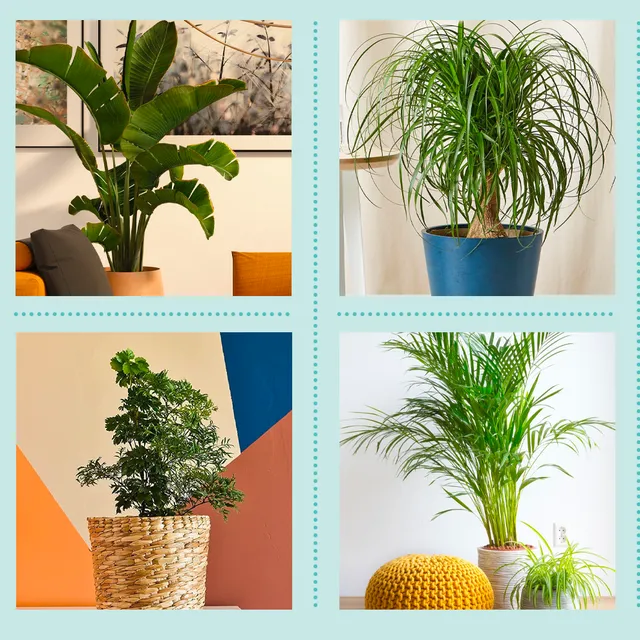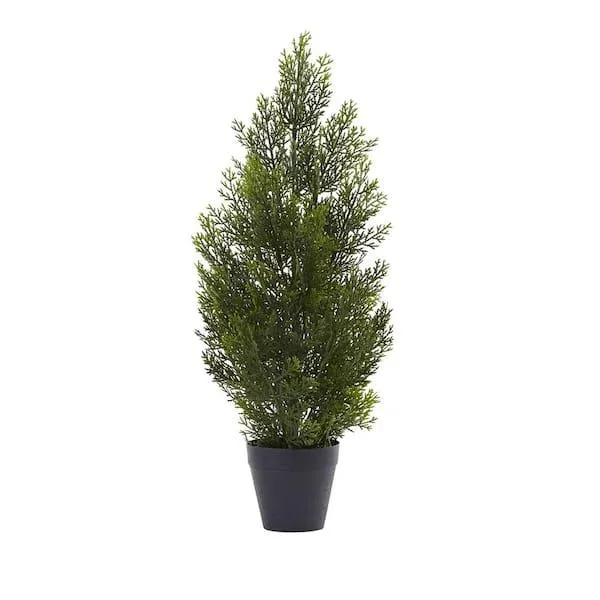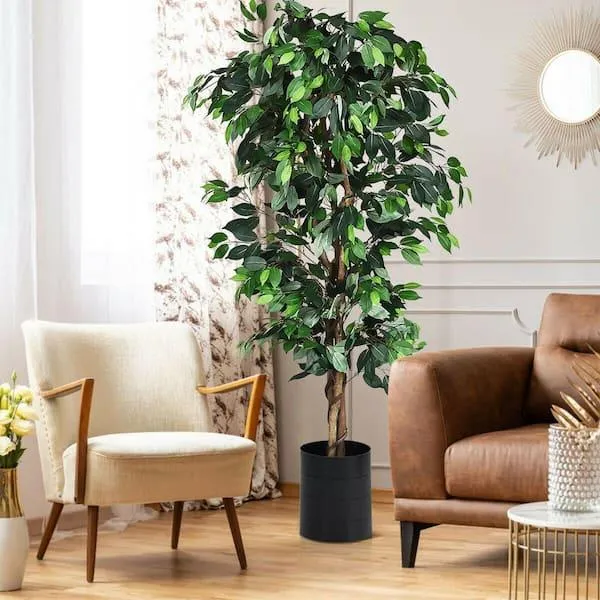Indoor Trees: Large Plants that Mimic the Look of Trees
If you love the look of trees but don’t have outdoor space, indoor tree-like plants are a gorgeous alternative. From my experience living in apartments over the years, choosing the right fake tree can go a long way in making a small space feel more lush and open. In this article, I’ll share the top indoor plant varieties that have a distinctly tree-like appearance.
Ficus Alii
The ficus ali’i is basically like having a miniature banyan tree indoors. Its branches spread out horizontally giving it a picturesque tree shape. It can grow over 6 feet tall under the right conditions so definitely provides a bold statement. Fun fact – in Hawaiian, “ali’i” means chief or ruler, reflecting this plant’s regal appearance. The broad, dark green leaves stay uniform in size creating the illusion of a lush canopy.
Kentia Palm
With its thick trunk and crown of graceful, arching fronds, the kentia palm is one of the best indoor imitations of a tropical palm tree. It’s sort of like bringing the vibe of Hawaii indoors! The slender oval leaves emerge light green and deepen with maturity. With proper light and care, a kentia palm can live for decades and eventually reach 10+ feet tall. It definitely adds an exotic palm tree essence to any space.
Chinese Evergreen
Though not as literal a tree replica as previous options, Chinese evergreen has a multi-stemmed habit and dense rounded foliage that lends itself to a quasi-bonsai aesthetic. Over time, a specimen plant can develop multiple woody trunks cascading downward, closely resembling a miniature tree. I have one Chinese evergreen passed down from my aunt that’s well over a decade old – they really are amazingly low maintenance as indoor plants go. The variegated varieties especially steal the show with contrasting green and cream stripes.

Indoor Trees Well-Suited to Specific Conditions
When choosing a faux indoor tree, it’s important to consider your space’s light levels, since not all tree-like plants thrive equally in low light. Here are some top options tailored to different lighting scenarios:
Low-Light Trees
- Rubber Plant – Dark, glossy leaves retain their beauty in very low light. Handles neglect well.
- ZZ Plant – Thick succulent stems and broad leaves allow it to survive where others would fail. Growth is slow.
- Snap Plant – Deceptively lush appearance for a plant suited even to north-facing windows. I’ve kept several thriving in near-dark corners.
Medium-Light Trees
- Hornbeam – Beautiful peeling bark adds texture. Allow bright indirect light for best variegation.
- Chinese Evergreen – Thrives in medium conditions but will drop lower leaves without enough sun. Versatile.
- Mulberry Fig – Tropical appearance with fast growth and heart-shaped leaves. Kind of picky about water though.
High-Light Trees
- Fiddle Leaf Fig – Statuesque and dramatic, but high maintenance for its great size. Watch for brown leaf edges in low light.
- Weeping Fig – Rustic cascading form is amazing for hanging baskets with direct sun. Sensitive to dry air.
- Avocado Tree – Grows a realistic miniature tree. Slow unless in very bright spot. May even fruit indoors with perfect care.
Caring for Fake Trees Indoors
No matter the variety though, taking care of an indoor tree means adapting to its needs sort of like learning a whole new language. Here are some tips I learned basically the hard way when I first started keeping houseplants:
Watering
In general, water when the topsoil is dry to the touch but not bone dry. Stick a finger an inch down to check moisture levels below surface. Under-watering is kind of safer than overdoing it with indoor trees. Allow soil to fully drain between waterings.
Fertilizing
During active growth periods, use a diluted liquid houseplant fertilizer every couple months. Read label instructions carefully—indoor trees don’t always need nutricious food like outdoors. Too much can burn delicate roots.

Pruning
Pinch back new stem growth occasionally to encourage bushy shape. Deadhead faded flowers. Cut back leggy sections to density. Keep an eye out for bugs and yellow leaves signaling health issues that may require pruning treatment.
Repotting
When roots poke through drainage holes, it’s time for a larger container with well-draining potting soil. Check roots—if matted and circling, tease out gently for better air access. Avoid shocking with too big a pot.
Pests and Problems
Ignore the occasional gnat or small bug usually. But check closely for infestation signs like webbing or black spots that may call for neem oil treatment. Brown crispy tips often mean it’s time to adjust watering or move to more humid environs.
So in summary, faking it with indoor tree-looking plants takes focus and TLC, but the payoff of a lush home jungle is totally worth the kinda learning curve. With diligent plant parent practice, you too can have impressively tall and bushy interior trees! Let me know if any other questions arise – happy to help more.

Indoor Plant Trees
| Plant | Size | Care Level | Light Needs | Water Needs |
|---|---|---|---|---|
| Chinese Evergreen | Moderate | Easy | Low-Medium | Let soil dry slightly between waterings |
| Fiddle Leaf Fig | Large | Moderate | Medium-Bright | Water when top inch of soil is dry |
| Parlor Palm | Moderate | Easy | Low-Medium | Let soil dry slightly before watering |
| Ponytail Palm | Small-Moderate | Easy | Low-Medium | Let top inch of soil dry before watering |
| Chinese Fan Palm | Large | Moderate | Medium | Water when top inch of soil is dry |
FAQ
-
What indoor plants look like trees?
There are a few indoor plants that have a tree-like appearance. Some good options are:
- Chinese Evergreen – It grows tall and has broad, dark green leaves. You can trim it to look like a miniature tree.
- Dwarf Umbrella Tree – As the name suggests, it’s a small version of an umbrella tree. The leaves have a neat, oval shape.
- Ficus Alii – Commonly called the minature rubber tree. It produces glossy leaves and stays fairly compact.
-
Do they need lots of sunlight?
Most indoor “trees” need moderate to bright light. However, the Chinese Evergreen can live in low light conditions. The Dwarf Umbrella Tree and Ficus Alii will struggle without at least four hours of sunlight each day. Go figure, right? I guess even tiny trees need their daily dose of vitamin D!
-
How often do they need watering?
Watering frequency varies depending on the plant. The Chinese Evergreen is pretty tolerate of dry conditions. You can let the soil dry out between waterings. The other two prefer consistently moist soil. Check the soil every 5-7 days and water when the top inch becomes dry. Keeping a schedule makes it easier to remember, IMO.
-
Do they grow fast?
Growth rate varies, but don’t expect fast gains. These plants are more like Bonsai than redwoods. The Ficus Alii might increase a few inches per year. The Dwarf Umbrella Tree is slower growing. Chinese Evergreen expands gradually through branching. Patience is key when raising indoor “trees” – you just gotta let the little guys do their thing at their own pace!

-
How do I prune them?
Light pruning helps these plants maintain their shape as indoor “trees.” For the Chinese Evergreen, remove mature or leggy branches down to the node. The Dwarf Umbrella Tree responds well to annual trimming to define the canopy outline. Remove upward growing stems from the Ficus Alii. Sterilize pruning shears between cuts to avoid disease spread. With routine light pruning, these plants keep their compact form for years.
-
Is there anything else I should know?
Watch for signs of bugs or disease. Mealybugs especially dig mini trees. Isolate infected plants and spray down with insecticidal soap as needed. These plants don’t need heavy feeding. A quarter-strength fertilizer in spring and summer usually does the trick. Finally, be patient – mini trees may seem slow, but with proper care they’ll reward you with their soothing presence for a long while.
